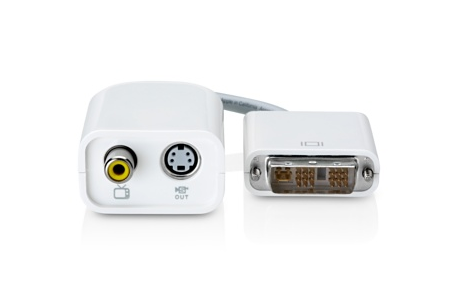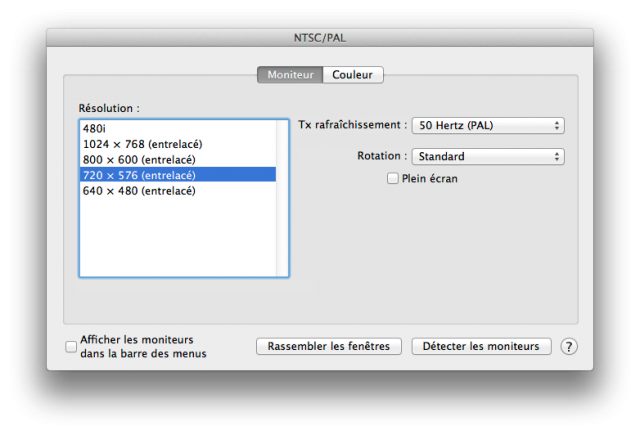Sometimes you need to connect a Mac to an outdated equipment, such as a CRT TV, a projector, or a pico projector. And these seldom manage digital interfaces: analogical interfaces are required.
Apple proposes adapters for this specific case, but the compatibility is quite low.
Four solutions:
• DVI to video (composite and S-Video) to € 20. Reference: M9267G.
• Micro DVI to video (composite and S-Video) to € 20. Reference: MB202G.
• Mini VGA to video (composite and S-Video) to € 20. Reference: M9109G.
• Mini DVI to video (composite and S-Video). Reference: M9319G.
Let’s start with compatibility. If you have a Mini DisplayPort computer : there are no simple solutions.
For the DVI model, it is usable on the Mac mini, the MacBook Pro 15 inches with DVI on, the MacBook Pro 17 inches with DVI on, some Mac Pro and Power Mac G5.
For Mac Pro, only two cards are compatible: the Radeon HD X1900 XT and Radeon HD 2600 XT HD. In both cases, the adapter is to be plugged into the second DVI connector.
On Power Mac G5, only the GeForce 6600-equipped with two DVI connectors is compatible.
For other computers (Power Mac G4, PowerBook, etc..) and the various adapters (Mini DVI to DVI, Mini DisplayPort to DVI, etc.), it is incompatible.
For the Micro DVI model, it is only compatible with the original MacBook Air (the only computer with this type of connector).
For the Mini VGA, it is compatible with computers that have this connector such as the iBook G4, some of the iBooks G3 – from the models « 16 VRAM » – the first 12-inches PowerBook, all eMacs but not the first model, the iMac G4 and iMac G5.
For the Mini DVI model, it is not fully compatible.
On the MacBook, only the Intel graphics (GMA X3100 or 950)-equipped versions are compatible. The few models equipped with a GeForce 9400M are not compatible.
The (few) Mac mini Mini DVI are not compatible.
iMacs have a Mini DVI output are all compatible.
Let’s do a small test
I connected a MacBook to a LCD TV via its composite input (it has no S-Video output). As expected, the quality is terrible. It was impossible to get a good full-size image : either there were black bars around the image or the image was larger than the screen, there was obviously a problem with the overscan.
In the proposed definitions, one finds the 480i60 (720 x 480 at 60 frames / s, NTSC), the 720 x 576 at 50 Hz and three definitions of PAL 4:3 640 x 480, 800 x 600 and 1024 x 768, in all three cases interlaced. With a CRT TV, the 1024 x 768 may not appear (this is due to my test with an LCD).
Funny little point: while the HD video available on iTunes can’t be read in VGA, it works in composite. The HDCP protection is clearly deactivated.
In fact, it is especially useful with devices that do not work in digital (DVI or HDMI) and it is to be avoided in other cases.




